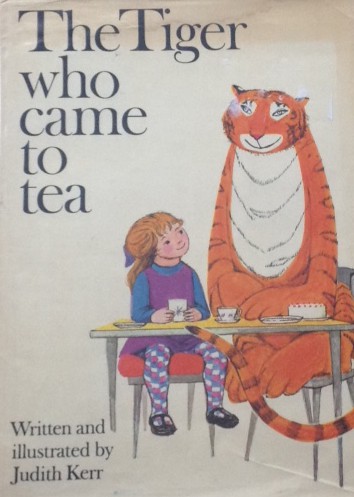Inspiring Young Readers
 posted on 27 Feb 2016
posted on 27 Feb 2016
The Tiger Who Came To Tea by Judith Kerr
It is quite difficult to write a review of what is undisputedly a classic picture book which is also now a recognisable brand with associated merchandise. I remember buying it and reading to my two year old daughter a few years after it was first published in 1968 and having that feeling of familiarity straight away - like welcoming a new friend who you know you are going to get on very well with I suppose. It was a big favourite with her from the first reading - as it was with the author's own young daughter Macy who often demanded imperiously that her mother should 'Talk the Tiger' showing a level of enthusiasm that led to Kerr deciding to translate the story into book form. I have read the book many times during my teaching career and still go to it as a reliable choice when reading to groups of children.
The author and illustrator celebrated her 90th birthday in 2013 which generated a great deal of media attention - including a sumptuous illustrated autobiography: 'Judith Kerr's Creatures: A celebration of her life and work'. Here she gives examples of her early drawing talent because she still has pictures she made which had been kept by her proud mother. This is all the more extraordinary as her father, a political journalist opposed to the Nazi regime, was in danger of being captured and this meant that the family were forced to flee from their native Germany to escape arrest (I do wonder whether I would think to pack my child's drawings under the circumstances). The family spent time in France and then eventually settled in England - episodes in her life that are recorded in her three wonderful semi-autobiographical novels. Kerr continued to draw, attended art school where she failed her final exam but carried on as a commercial illustrator and then worked for the BBC until she became a stay at home mother for some years. I have been lucky enough to hear her speak at several literary festivals and have always been impressed by her gentle self deprecatory manner. She is now a tiny twinkly little old lady who seems to delight in recounting what inspired her to write - I would happily see her again.
I'm sure that everyone reading this probably knows the book very well so I don't want to spend much time retelling the story. It is a very satisfying slim volume and the picture on the cover is beautifully composed with the two main protagonists sitting at the table. My daughter used to love the little girl's patterned tights and I can remember trying to buy some that were the same colour (surprisingly, they are still not available to buy). The story is an old-fashioned and uncomplicated story about a minor family crisis that is resolved. The huge stripey tiger arrives at the front door and is immediately invited in by Sophie's very accommodating mother. He is made welcome and goes on to steadily consume all the food and drink in the house, including all the water in the tap so that Sophie is unable to have a bath ( the part her own children liked the best). When he eventually goes, leaving a trail of domestic havoc, the mother is a bit hopeless and has to wait until dad arrives home from work to be able to think of a solution. They then decide to go out to a cafe for a delightfully unhealthy meal of sausages, chips and ice cream. What a treat to go out in the dark street past all the lit up shop windows wearing nightclothes under her coat and this is probably my very favourite illustration in the book.
So what makes it a picture book classic? It certainly fulfils plenty of the traditional criteria: it has survived and is treasured by different generations; it has been interpreted in several different ways including being performed on the stage; it has been widely translated; and, the illustrations are iconic. It has also been written about by many academics, which apparently amuses the author as she was not aware for instance that the Tiger may be seen as a metaphor for oppression based on her experiences as a child in Nazi Germany or that he represents a general sinister threat to Sophie's childhood innocence. As Kerr has said ' Sometimes a tiger is just a tiger'. For me, it is a classic because I have never come across a child that doesn't enjoy the story and it always feels fresh and interesting, no matter how often it is read. That really is wonderful accomplishment for any author.
Karen Argent
26th February 2016